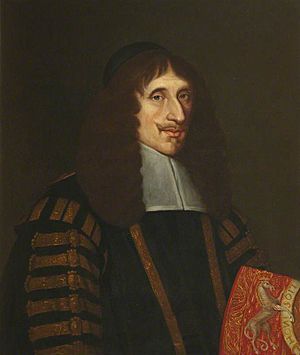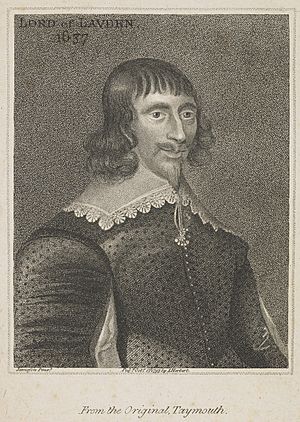John Campbell, 1st Earl of Loudoun facts for kids
Quick facts for kids
The Earl of Loudoun
|
|
|---|---|
| John Campbell | |

John Campbell, 1st Earl of Loudoun
|
|
| Lord Chancellor of Scotland | |
| Personal details | |
| Born | 1598 |
| Died | March 1662 |
| Spouse | Margaret Campbell |
| Children | 4 |
John Campbell, 1st Earl of Loudoun (born 1598 – died March 1662) was an important Scottish politician. He was also a Covenanter, which meant he supported a special agreement to protect the Presbyterian Church in Scotland.
As a young man, John Campbell traveled to other countries. In 1620, he married Margaret Campbell, who was the heiress of Loudoun. This meant he could take a seat in the Parliament of Scotland. In 1633, King Charles I stopped him from becoming an Earl. This was because John Campbell strongly disagreed with the King's idea of having bishops lead the church.
He became a leader in organizing the Covenanters between 1637 and 1638. In 1639, he led an armed uprising in Scotland. He was also sent to talk to King Charles I in 1640. He was put in the Tower of London for a short time. After being freed, he joined the Scottish army that invaded England in August 1640.
John Campbell was sent to London again to negotiate peace. From 1641 to 1660, he served as the Lord Chancellor of Scotland. In 1641, he was finally made the Earl of Loudoun. Between 1642 and 1647, he often went to King Charles I from the Scottish Parliament. In 1650, he was at the crowning of Charles II of Scotland. He also fought at the Battle of Dunbar.
He joined a rebellion in the Scottish Highlands in 1653. However, he gave up when it was clear they could not win. He was later fined by Charles II in 1662.
Contents
Early Life and Political Beginnings
John Campbell was born in 1598. He was the oldest son of Sir James Campbell of Lawers. His mother was Jean, the daughter of James, Lord Colville. After traveling abroad, King James VI of Scotland made him a knight.
In 1620, John Campbell married Margaret Campbell. She was the oldest daughter of George Campbell, master of Loudoun. When her grandfather, Hugh Campbell, died in 1622, Margaret became the Baroness Loudoun. Because of his wife's title, John Campbell was able to join the Parliament of Scotland.
Disagreements with King Charles I
King Charles I planned to make John Campbell the Earl of Loudoun in 1633. However, this plan was stopped. John Campbell had joined with other Scottish leaders, like Earl of Rothes. They disagreed with the King in Parliament. They especially opposed a law that let King Charles I decide what church leaders should wear.
Soon after this law, Scottish bishops started wearing special clothes again. In 1636, the King also ordered new church rules and a new prayer book. He did this without asking the Scottish church assembly. John Campbell's opposition to the King's plans made him popular. In December 1637, he spoke to the Privy Council. He explained the complaints of those who opposed the King and gave them a petition.
Leading the Covenanters
In 1638, groups called "tables" were formed. The "Covenant" agreement was also renewed. John Campbell played a very important part in these events. He was chosen as an elder for the town of Burgh of Irvine in the church assembly. This assembly met in Glasgow in November 1638. He was also appointed as an advisor to the leader of the assembly.
In 1639, John Campbell and his friends took control of several castles. These included Strathaven, Douglas, and Tantallon. They held these castles for the popular party. He marched with the Scottish army to the border. He was one of the Scottish representatives at the Pacification of Berwick peace talks. This peace agreement was signed on June 18, 1639, but it did not last long.
Imprisonment and Negotiations
On March 3, 1640, John Campbell and Earl of Dunfermline met King Charles I. They were representatives from the Scottish Parliament. They complained that the King's representative had stopped the Scottish Parliament too early. This happened before they could finish their work.
The King did not answer their complaint. A few days later, John Campbell was sent to the Tower of London. This was because he admitted writing a letter. The letter was addressed "To the King" (of France). It asked for help from the French king. This letter was signed by several Scottish lords and generals. John Campbell said the letter was written before the peace agreement. He also said it was never sent. He argued that if he had done anything wrong, he should be judged in Scotland. After several months, he was released. This happened after Marquis of Hamilton spoke up for him.
Becoming Lord Chancellor
On August 21, 1640, the Scottish army entered England. John Campbell was with them. He took part in the Battle of Newburn on August 28. He was also one of the Scottish representatives at Ripon in October. They agreed to stop fighting. The peace talks then moved to London. There, the Scottish representatives were welcomed by the English Parliament.
In August 1641, the King himself opened the Scottish Parliament. The peace treaty with England was approved. Important titles were given to the main Covenanters. This was because the King thought they could help him. John Campbell was made Lord Chancellor of Scotland on September 30, 1641. He took his oath and received the Great Seal. He was also given a yearly payment of £1,000. His title of Earl of Loudoun was finally allowed. He was also made the first commissioner of the treasury.
Civil War and Later Life
In 1642, John Campbell was sent to offer peace talks between the King and the English Parliament. He met with King Charles several times. However, he failed to achieve peace and returned to Scotland. After the Civil War began, he was sent to Oxford. He tried to mediate for peace again. But King Charles would not agree that the Scottish council had the right to mediate.
In 1643, John Campbell was again chosen as an elder for Irvine. However, he turned down the role this time. In the same year, he was invited to attend discussions in Westminster. In 1645, he was a Scottish representative at the treaty of Uxbridge. He tried his best to convince King Charles I to give in to Parliament's demands. But his efforts did not work. At Newcastle, he again tried to persuade Charles, who was then held by the Scottish army.
In 1647, John Campbell and other Scottish Earls met with King Charles at Carisbrooke Castle. They made a secret agreement called the "Engagement" with Charles. When he returned to Scotland, he became president of Parliament in March 1648. However, he changed his mind and opposed the "Engagement." This was because more extreme Covenanters said it was an "unlawful agreement." He had to apologize publicly in the High Church of Edinburgh for his earlier support.
As Lord Chancellor, he helped at the crowning of Charles II in Scone on January 1, 1650. He was also at the Battle of Dunbar. Some of his letters to Charles II were found by Cromwell. These letters were later published by the English Parliament.
After the Battle of Worcester in September 1651, John Campbell went into the Highlands. In 1653, he joined other Royalists who had risen up for the King. But when leaders started to disagree, he left them. He eventually surrendered to General George Monck. It was clear that fighting more was useless. John Campbell and his oldest son were not included in Cromwell's act of forgiveness. His wife was given £400 a year from his estates.
After the King returned to power, John Campbell lost his job as Chancellor. However, he still received his pension. In 1661, he strongly defended his friend, Marquess of Argyll. Argyll was accused of a serious crime against the King. Argyll was executed, and John Campbell worried he might face the same fate. In 1662, he was fined £12,000 (Scottish pounds). He died in Edinburgh on March 15, 1663. He was buried in the Loudoun Kirk in East Ayrshire.
Family Life
John Campbell and his wife, Margaret, had two sons and two daughters. Margaret lived longer than him. His oldest son, James, became the next Earl. James died in Leyden.
Later, when James, the fifth Earl (a grandson of the second Earl), died, the title went to his only daughter, Flora. She married Francis, 2nd Earl of Moira. He later became the 1st Marquis of Hastings. When Henry, 4th Marquis of Hastings, died in 1868, his oldest sister Edith became the Countess of Loudoun. The title then passed to her son, Charles, 11th Earl of Loudoun.


